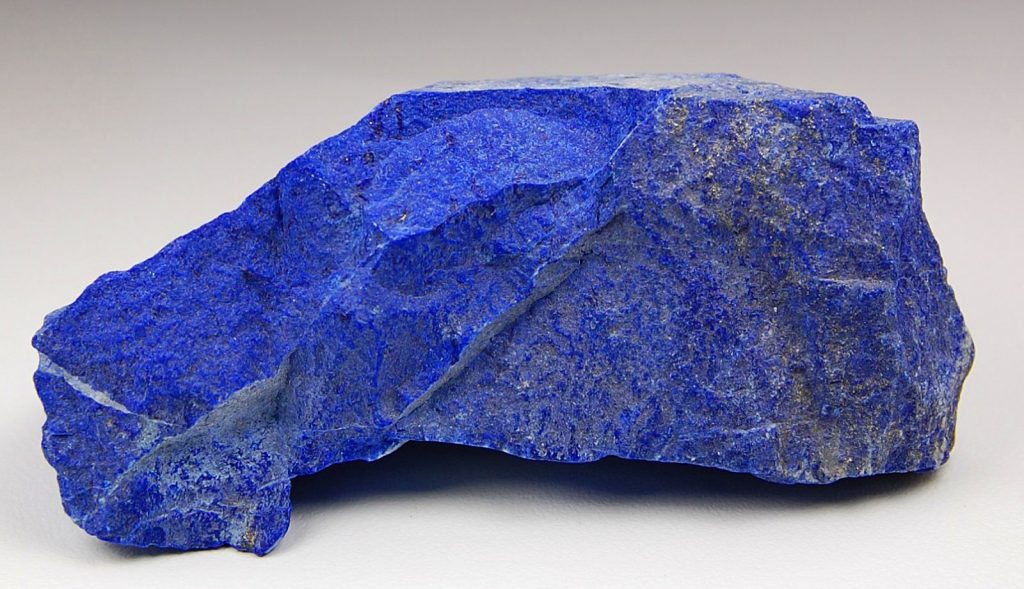Krispin Joseph PX
The subject of Art history brings many unknown ‘topics’ into the spotlight. There are exciting materials and objects from different locations and times and diverse cultures: Egyptian, Mesopotamia, Indus Valley and many others. The world of objects and artefacts is fascinated with stories and historicity.
Here introduced a unique piece of material from the past; ‘Lapis Lazuli,’ a blue stone from Northern Afghanistan in ancient times that spread out the old civilizations and settlements. We must start thinking about the archaic period and stay tuned with old stories of objects- if the period starts from 10000 BCE. ‘Things’ are essential; human nature and activities developed around them. This essay tries to observe ‘Lapis lazuli as material and objects—the journey of material and the transformation period of material to artefacts. In ancient times, Lapis lazuli got from Badakhshan province in northern Afghanistan. That blue stone travels through our ancient history, connecting major ancient civilizations and distant lands with a mesmerising colour of blue.
Stone never travels alone; that journey is a part of the epic journey of humans. When starts Lapis lazuli’s material form a travelogue? According to the Archaeological Survey of India, the first lapis lazuli artefacts get it from the early Indus Valley civilization site Bhirrana1. From here Archaeological team get many artefacts like a copper bangle, copper arrowhead, bangles of terracotta, beads of carnelian, lapis lazuli and steatite, bone point, stone saddle and queen. The period of these settlements is between 7570- 6200 BCE. This is the first evidence that stone started the journey to the very early period of human settlement. Ancient people may try to settle with the things created from various materials.
The lithic tools associated with the Hakra wares primarily consist of microliths, perhaps surviving from the neolithic tradition of the Indus valley: Lapis Lazuli, terracotta beads, and shell objects were found along with other materials from Early Harappan2 sites. Evidence of the early period of Indus Valley civilization gives the premature travels of this material; Lapis Lazuli transformed into objects in earlier cultures, primarily ornaments.
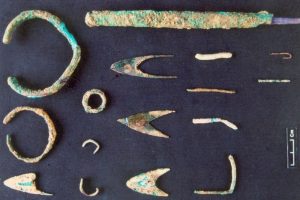
credit: excnagasi.in
If we get the artefact from 7570 BCE, when did they start the journey as a material? How many thousand years do they travel as a blue stones? Travel as a material form is different from the state of objects. This period is a significant phase of human evolution. Humans are working on inventing tools. Without tools, there are no objects and artefacts. If we get the things, that means the tools are already there. Active human interaction makes the tools possible. Sharing technology and ideas was the core artistic practice in ancient times. Lapis lazuli reached Bhirrana in 7570 BCE. From Sar e sang province to Bhirrana, was a trade route open then? Or did nomadic people travel here, and there is expected at that time?
One must always assume the time journey of lapis lazuli material history. There is no evidence of that. Thousands of years may take to invent some tools to work with lapis lazuli and other materials. Neolithic tools started work with Lapis lazuli and used other devices and techniques in different regions and artistic skills. This stone has become an essential material in a three-fold cultural sequence- Pre Harappan, Early Harappan and Mature Harappan.
Material journey
Ancient route maps indicate how the material moves from place to place and how far they are. According to the Archaeological evidence, Lapis lazuli travelled to Mesopotamia in 4000 BCE from Afghanistan. The almost 2500 km route became known as Lapis Road. On this route, not only lapis lazuli but many materials were also carried by humans between Mesopotamia and Afghanistan. ‘Mesopotamia was the commercial centre for this treasured material, transformed by its artists into luxury objects, according to Jean Wyart, Pierre Bariand, and Jean Filippi3.
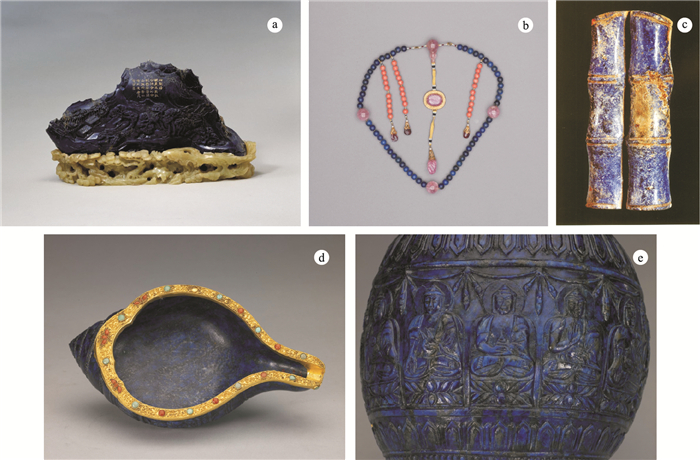
credit: http://jogg.cug.edu.cn/
Bhirrana’s people started making lapis lazuli beads in 7570 BCE. The possibility of making lapis lazuli artefacts is there in Indus Valley. But only a few lapis lazuli artefacts get it from Indus Valley at any time. Why? People of the Indus Valley may believe and treat it as a valuable material. Ideas may be the most valuable items traded in that period. Ideas are traded for valuable materials. Nomadic peoples found this stone in the mountain range, and it became popular in ancient cities; that is a way of spreading out in time.
Material is transformed into objects, and that is a challenging way. Ancient peoples struggle with them, fight with them, and stay with them. That is the way of understanding ancient times. The material became a point of interaction, ideas, technologies and culture. What is the point of value-adding this material in between exchanges? Without exchange, how this material became valuable? Many questions are there, and answers should be there, also. Materials make life more flexible and inventive. Materials bring the tools, technology, and mode of production. Material culture begins when different kinds of material come with endless possibilities emerge when new materials come.
The distance of the source of the materials makes the material more valuable. In the case of lapis lazuli, space creates value. Lapis lazuli is most valuable because it comes from a far distance. From the Afghan mountain range to the early Indus Valley, sites like Bhirrana need long journeys to reach. If we get an artefact from Bhirrana in 7570 BCE, when that material started to travel, and when that material converted to objects.
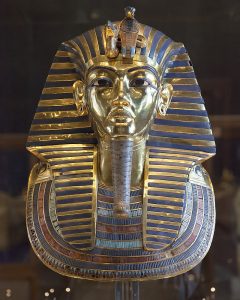
The material itself is valuable. That value adds to who uses or owns that material. So, possession of material is a value-added activity. Value is added to the person’s social status and visibility. That form of social value slowly emerges related to many kinds of materials. ‘An artefact is defined as anything made or modified by people, so artefacts are not just ‘things’ but are intricately linked with people’s needs, capabilities, and aspirations, Linda Hurcombe writes4. According to Linda Hurcombe, artefacts strongly connect with people’s needs, abilities and aspirations. That’s all directly related to the materials and tool making. Objects have a time or phase of material and engaging with tools.
Why is material history so important? History is related to human interactions and engaging with various circumstances. That long road carries human stories, courage, craftsmanship, exchanges, and sharing of ideas. Material culture is a core area of all kinds of civilizations revealed in excavations, and material culture is a part of human nature. ‘As much as societies today communicate via objects, so the objects of the past are how we can try and extract information about past societies’, Linda Hurcombe’s assumptions are correct. This story is about the artefacts and material also.
The material journeys also reveal the whole storyline of human interactions, from Afghanistan to Bhirrana, and how they reach who travel from land to land. Indus people go and collect, or they purchase from nomadic peoples. If they buy or order from nomadic, what do they give to them? The barter system slowly evolved; valuable materials needed valuable products or valuable materials. Useful material became the most valuable object, the story of human development. Objects are the physical remains of the past, which indicate the journey of material form, working with tools, and valuable history.
Royal mines and medicinal value
Some interesting information was available when I checked the details about the Lapis Lazuli mining place. The Climatic conditions of the mining places are crucial; miners can only access the mines five months a year. June to November is the period of accessibility. The rest of the time, all places are under the snow. Travelling from Kabul to the mining place takes more than five days. In these circumstances, Lapis Lazuli mines are also known as royal mines. We get something valuable from the mountain top, but it has never been available. Nature played a key role here. Materials are more valuable than we believe.
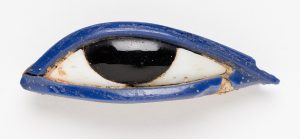
This stone travels to the ancient worlds like Persia, Iraq, Egypt and later to Roman-Byzantine- Ottoman empires. Then Lapis Lazuli went to ancient Chinese and south-east Asian worlds, more south to the ancient Indus Valley Civilization and later Buddhist, Hindu, and Muslim empires. This travelogue is in the form of material. There is another travelogue in pigment form. This stone is converted as a pigment and used as a blue colour. In Renaissance Europe, Lapis Lazuli pigment is known as ultramarine blue and was used by famous artists. Patronage gives those costly pigments to paint godly figures and events.
These stones became the pathway of the ancient cities to their world of trade and commerce, and this material became valuable for the old worlds. A significant transformation of these materials happened in Mesopotamia. This stone was converted into a sacred material in Mesopotamia in ancient times; that is the story before 3000 BCE.
Bhirrana to Mesopotamia (7570 BCE to 3000 BCE) is a long journey between the two periods. Lapis Lazuli road was slowly active before 3000 BCE: Lapis lazuli and other materials may have been traded through this route. People move from one place to another; they may search for a better living place.
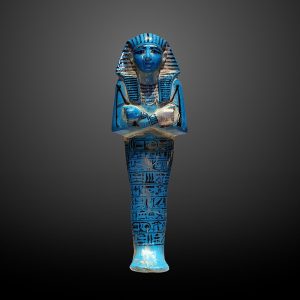
The value of the materials in the ancient world is apparent. Lapis Lazuli is a part of our medicinal practice; in Mesopotamia, the Lapis Lazuli is used as an eye treatment; they mix with ghee and honey to make an eye ointment. In India, these stones are used in Tantric practices as mineral drugs. Ancient Egyptian medical writings explain the medical use of Lapis Lazuli. Two papyrus scripts refer to using Lapis Lazuli in treating the eye. Assyrian people also used this stone as an eye ointment. Ancient people believed in and practised supernatural powers; Lapis Lazuli and many other stones were used in this practice.
These stones are become the symbol of dignity and part of magical, ceremonial practices and were offered as a royal gift and tribute; Lapis Lazuli has a symbolic meaning of joy, delight and tranquillity in ancient worlds. It was considered the colour of heaven. That’s why Michelangelo used Lapis Lazuli pigment to paint ‘The Last Judgement. Lapis Lazuli pigments are deemed valuable and ritualistic in Renaissance Europe. Christianity treats Lapis Lazuli pigment as a holy material to portray a heavenly atmosphere.
From the royal cemetery of Ur, excavations reveal fantastic objects fashioned from the Lapis Lazuli. They keep all valuable and worthy items with them, including Lapis Lazuli objects, for use after death.
Trade and commerce
The emergence of Mesopotamia as a civilization and urban city at the beginning of 3100 BCE made Lapis Lazuli valuable. This material is there already, but the desire for this material only started after the emergence of Mesopotamia cities. The townspeople collect precious stones and other valuable items from nomadic people, who may bring rare materials from a distant land. We need archaeological evidence to make clear the nomadic people’s contribution to the history and movement of materials.
Scholar Marc Van Mieroop asks the question about Ancient Mesopotamian social structure, how did they manage agriculture production and additional surplus to acquire foreign materials for a display of wealth in palaces and temples5? He mentioned the foreign materials for displaying wealth in the castle and temples; that is the point. Mesopotamian people collected foreign goods- Lapis Lazuli and others, to show their wealth and royalness for public and interior architecture. That is why materials flowed to Mesopotamia happened, and they became precious. Marc Van De Mieroop argues that the economy cannot be separated from the existing social settings. Developed society creates ornaments and decorative art objects. In De Mieroop’s book, there is also an argument between the private sector and the state. He believes the private sector is also robust, like the state structure. Materials are not only purchased by the state but also by private groups. The use of these materials was high in Mesopotamia. At the same time, the Indus Valley civilization has become a mature one.
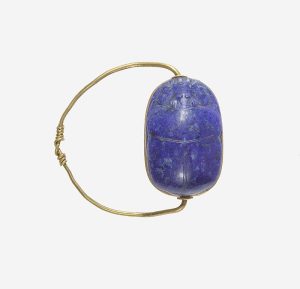
Mesopotamians kept granaries filled with gold, wheat, copper, tin, blocks of Lapis Lazuli and other things6. These are the core prosperity materials for the city people. “The often-repeated idea that grain was shipped from Urk to Afghanistan to acquire Lapis lazuli is ludicrous. By the time the human or animal carriers had completed their journey of over 2000 kilometres, they would have consumed their entire load. More valuable and less bulky items needed to be used’’7, writes De Mieroop. The material journey of Lapis Lazuli is converted into an object journey in Mesopotamia. That journey is one of human history’s most valuable and luxurious journeys. Lapis lazuli became the essential material connecting royal peoples and royalness.
“Meluha is now usually located in the Indus Valley region when mentioned in early texts, though it might be of wider reference covering the shores of what in modern times has been called the Indian Ocean. It was a land of seafarers whose boats are mentioned in the later third Millenium BC Mesopotamian texts: its exports included timber and wooden furniture, copper, gold dust, Lapis Lazuli, carnelian, birds (including the peacock), and such manufactured objects as multicoloured ivory birds, a cornelian monkey, and a red dog. People from Meluha were also settled in Mesopotamia”, Archaeologist PRS Moorey wrote8. According to Moorey’s arguments, we can conclude the material value of that time. These people are already modern in many terms, importing goods and materials from a distant land and creating an urban city.
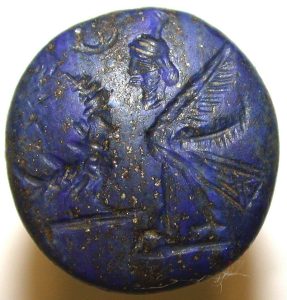
PRS Moorey mentions the use of eye inlays in later dynastic periods in Mesopotamia, and the use of Lapis Lazuli for the eyeball is widespread among the royals. “Sufficient Akkadian royal sculpture survives to indicate definite trends in the use of stone in royal workshops”, Moorey writes9. People are more interested in stonework, so craftmanship grows that way too. The stonework is only possible with metal tools, so a metal workman is already there.
Moorey mentions that the use of Lapis Lazuli changed from period to period in Mesopotamia. “The textual information is sufficient at least to provide information on its continuing use for beads, where it ranks Lapis lazuli, cornelian and calcite as the preferred combinations in fine jewellery with gold”10, writes Moorey. The change in the taste of valuable materials and objects vary in periods. Lapis Lazuli is the most valuable of all time. The blue colour became popular in the ancient world, leading us to the archaic period’s zodiac symbolism. In zodiac symbolism, Lapis Lazuli is a symbol of Jupiter, a “masculine solid form of the blue colour, such as royal blue”11. This stone maintains that magical quality in ancient times. The period of magic practice and supernatural belief is the precise pathway of many kinds of rocks and other materials.
This stone is also the point of cultural interconnections to other places and land. How many people go between these interactions and transactions of these stones? When ancient people produced seals, Lapis lazuli became the central element of royalness. Lapis Lazuli became the most exotic stone for seals. Precious stones became valuable and luxurious when the seal became the iconographic representation of royalness and richness.

The great prestige and value of Lapis Lazuli lent it a unique role in the cult, as in its use for foundation inscriptions (Ellis 1968), gave it a broad metaphorical role in literature, and ensured its place in magic texts. “Lapis- like’ was a standard metaphor for unusual wealth from early in the extant literary tradition, and this stone was for long synonymous with gleaming splendour, an attribute of the gods and heroes. Although the stone was imported into Mesopotamia, the majority of manufactured Lapis Lazuli so far recovered from ancient sites there is recognizably local in style12; this critical portion from the book of Moorey gives the details of Lapis Lazuli’s position in that society. How can a phrase like ‘Lapis- like’ become a standard metaphor? The role of that material is to create a myth about the material. That myth works differently and makes a clear standpoint to the general people. Lapis Lazuli became the mythical character for the elite, royal and known people. That myth slowly evolved to the sphere of all ancient worlds, and that fictional nature of sacredness travelled to Renaissance Europe as a pigment. That pigment also held an exalted position in Christianity during the Renaissance period.
Reference
1) Excavation Branch-Nagpur, Archaeological Survey of India,
Excavation Bhirrana | ASI Nagpur (excnagasi.in)
2) Dikshit, K.N “Origin of Early Harappan Cultures in The Sarasvati Valley — Recent Archaeological Evidence and Radiometric Dates” Scrible.com Origin of Early Harappan Cultures in The Sarasvati Valley — Recent Archaeological Evidence and Radiometric Dates | PDF | Archaeology | Nature (scribd.com)
3) Wyart, Jean; Bariand, Pierre; Filippi Jean. ‘’Lapis-Lazuli from Sar-E-Sang, Badakhshan, Afghanistan’’ gia.edu, Gems & Gemology, vol 17, winter 1981 Lapis-Lazuli from Sar-E-Sang, Badakhshan, Afghanistan | Gems & Gemology (gia.edu)
4) Hurcombe, Linda. Archaeological artefacts as material culture. London: Routledge, 2009.
5) De Mieroop, Marc Van. The ancient Mesopotamian city. London: Clarendon Press-Oxford, 1997.
6) De Mieroop, Marc Van. The ancient Mesopotamian city. London: Clarendon Press-Oxford, 1997.
7) De Mieroop, Marc Van. The ancient Mesopotamian city. London: Clarendon Press-Oxford, 1997.
8) Moorey, PRS. Ancient Mesopotamian Materials and Industries: the archaeological evidence. London: Clarendon Press Oxford, 1994.
9) Moorey, PRS. Ancient Mesopotamian Materials and Industries: the archaeological evidence. London: Clarendon Press Oxford, 1994.
10) Moorey, PRS. Ancient Mesopotamian Materials and Industries: the archaeological evidence. London: Clarendon Press Oxford, 1994.
11) Moorey, PRS. Ancient Mesopotamian Materials and Industries: the archaeological evidence. London: Clarendon Press Oxford, 1994.

Krispin Joseph PX, a poet and journalist, completed an MFA in art history and visual studies at the University of Hyderabad.

